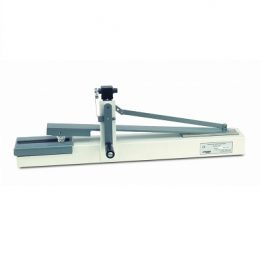The TABER® Rotary Platform Abrasion Tester – Model 5135 / 5155 is commonly referred to as the Taber Abraser (Abrader) or Rotary Platform Dual (Double) Head Tester.
Taber tests involve mounting a flat specimen approximately 100mm square or round to a turntable platform that rotates on a vertical axis at a fixed speed. The standard material thickness that can be evaluated with the Taber Rotary Abraser is 6.35 mm (materials greater than 6.35 mm but less than 40 mm can be tested with optional accessories). Two genuine Taber abrasive wheels, which are applied at a specific pressure, are lowered onto the specimen surface.
Characteristic rub-wear action is produced by contact of the test specimen against the sliding rotation of the two abrading wheels. As the turntable rotates, the wheels are driven by the sample in opposite directions about a horizontal axis displaced tangentially from the axis of the sample. One abrading wheel rubs the specimen outward toward the periphery and the other, inward toward the center while a vacuum system removes loose debris during the test. The wheels traverse a complete circle on the specimen surface, revealing abrasion resistance at all angles relative to the weave or grain of the material. The resulting abrasion marks form a pattern of crossed arcs in a circular band that cover an area approximately 30 cm2.
Each turntable has dual abrading arms that are precision balanced. Independently operated, the abrading arms can be raised (or lowered) to mount or inspect specimens. Each arm is precision balanced and will apply a load of 250 grams against the specimen, exclusive of the weight of the wheel. To increase the load to 500 or 1000 grams, a mount for auxiliary weights is located on the outside of the abrading wheel bearing assembly. This location ensures that weights are concentric with the abrading wheel. A stud on the rear end of the abrading arm is used to carry an optional counterweight (used to reduce the load by 50, 125, 150 or 175 grams).
Taber Abraser Model 5135 or 5155 offer the following standard features:
- Specimen turntable speed control options of both 60 rpm and 72 rpm.
- Easy-to-use operator interface that includes tactile feel buttons and a four line digital display. Simple on-screen instructions allow the operator to change the test parameters via the MENU button. An internal memory stores the settings.
- A vacuum system is included and is critical for the proper operation of the instrument. The vacuum nozzle(s) is hinged to an adjustable mounting at the rear of the housing. A precision vacuum nozzle adjustment control allows the height to be modified for accommodating varying specimen thickness.
- Stainless steel weights are furnished to provide standard wheel loads of 500 or 1000 grams. Weights are actually 250 or 750 grams, but are marked to show total load on each wheel. This marking includes the weight of the abrading arm (250 grams).
- A Quick Release Mounting Hub permits quick wheel mounting without the need of a locking nut, increased clearance for the vacuum pick-up nozzle and a larger viewing area for the test specimen. A beveled retaining nut provides a positive locking force on the wheel hub retaining lip making certain that the wheels remain securely fastened until disengaged.
- Assembled in a sturdy, sealed aluminum housing.





